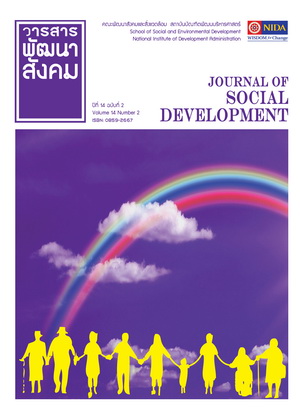การประเมินผลสำเร็จตามมาตรฐานคุณภาพชีวิตการอยู่อาศัยในชุมชนของการเคหะแห่งชาติ ประจำปี 2553
Main Article Content
Abstract
Abstract
The present study was aimed to assess the community’s achievement level of implementing activities to promote the quality of life of residence in the projects of National Housing Authority (NHA) operated in 2010 in both the output and outcome. The projects assessed comprised 23 Uer - Arthon projects and 1 community housing project, using an evaluative research method and focusing on summative evaluation. Key indicators for community’s achievement assessment of output include participation and satisfaction toward the benefits of community housing project. Assessment of outcome involved the residential quality of life in NHA’s communities for 4 element: the strength of community, warm family, the strength of community economy, and good environment. The data for assessment derived from 8,919 household representatives.
Results suggested that:
In overall the participation in activities conforming to the quality of life standard of NHA was at level 5 (high), the satisfaction towards the activities was at level 3 (moderate) with mean 3.12, and the quality of life in line with NHA’s quality of life standards was at level 3 (moderate) with mean 3.24.
The community’s achievement in operating the residence standards in NHA’s communities in 2010 was at level 4 (relatively high) with mean 3.74, and such achievement of the projects executed by the co-operatives was higher than that of the companies and Tambon Administrative Organization of Municipality.
The important ranking among the 4 elements toward the quality of life standard found that all elements had some significantly effect on the quality of life standard with the explaining power of 42.8 % (R square = 0.428). The orders of significance are 1) good environment, 2) the strength of community, 3) the strength of community economy, and 4) warm family, respectively.
Key words: The Performance Evaluation, Standard of Living, National Housing Authority
บทคัดย่อ
การ ศึกษาในครั้งนี้มีวัตถุประสงค์หลัก เพื่อประเมินผลระดับความสำเร็จของชุมชนที่ดำเนินการตามกิจกรรมส่งเสริม มาตรฐานคุณภาพชีวิตการอยู่อาศัยในชุมชนของการเคหะแห่งชาติ ที่ดำเนินการในปีงบประมาณ 2553 ทั้งในด้านผลผลิต (Output) และผลลัพธ์ (Outcomes) โครงการที่ประเมินประกอบด้วยโครงการเอื้ออาทร 23 โครงการ และโครงการเคหะชุมชน 1 โครงการ ตัวชี้วัดหลักที่ใช้ในการประเมินผลระดับความสำเร็จของชุมชนด้านผลผลิต ประกอบด้วย การมีส่วนร่วมและความพึงพอใจในการได้รับประโยชน์จากกิจกรรมในชุมชน ส่วนด้านผลลัพธ์ ได้แก่ มาตรฐานคุณภาพชีวิตใน 4 องค์ประกอบ คือ ชุมชนเข้มแข็ง ครอบครัวอบอุ่น เศรษฐกิจชุมชนเข้มแข็งและสภาพแวดล้อมดี ข้อมูลที่ใช้ในการประเมินได้จากผู้แทนครัวเรือน จำนวน 8,919 คน
ผลการประเมินพบว่าการ มีส่วนร่วมในกิจกรรมตามมาตรฐานคุณภาพชีวิตของการเคหะแห่งชาติ ในภาพรวมอยู่ในระดับที่ 5 (ระดับมาก) ส่วนความพึงพอใจในกิจกรรม มีค่าเฉลี่ย 3.12 อยู่ในระดับที่ 3 (ระดับปานกลาง) คุณภาพชีวิตตามมาตรฐานคุณภาพชีวิตของการเคหะแห่งชาติ มีค่าเฉลี่ย 3.24 อยู่ในระดับที่ 3 (ระดับปานกลาง)
ผลสำเร็จของชุมชนที่ได้ดำเนินการ ตามมาตรฐานการอยู่อาศัยในชุมชนของการเคหะแห่งชาติ ประจำปี 2553 มีค่าเฉลี่ย 3.74 อยู่ในระดับที่ 4 (ระดับค่อนข้างมาก) และผลสำเร็จในโครงการซึ่งบริหารงานโดยสหกรณ์สูงกว่าการบริหารงานโดยบริษัท และ อบต. หรือเทศบาล
ผลการวิเคราะห์ลำดับความสำคัญขององค์ประกอบที่ มีผลต่อมาตรฐานคุณภาพชีวิตในภาพรวม พบว่า ทั้ง 4 องค์ประกอบมีความสำคัญอย่างมีนัยสำคัญทางสถิติและสามารถอธิบายความแปรปรวนใน มาตรฐานคุณภาพชีวิตได้ ร้อยละ 42.8 (R square = 0.428) โดยองค์ประกอบสภาพแวดล้อมดีมีความสำคัญเป็นลำดับแรก รองลงมาได้แก่ องค์ประกอบชุมชนเข้มแข็ง เศรษฐกิจชุมชนเข้มแข็ง และครอบครัวอบอุ่น ตามลำดับ
คำสำคัญ: การประเมินผลสำเร็จ มาตรฐานการอยู่อาศัย การเคหะแห่งชาติ

